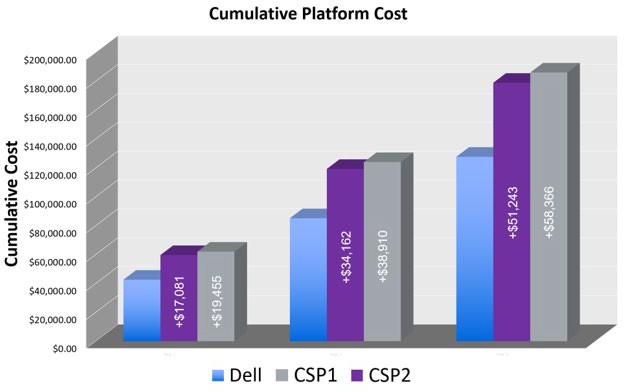Assets

On-prem vs. Public Cloud: Understanding the true cost of running steady-state workloads in the public cloud
Fri, 16 Apr 2021 09:08:01 -0000
|Read Time: 0 minutes
Infrastructure is not the only thing that may be more expensive in the public cloud than on-premises.
Organizations have found value with their investments in Public Cloud; however, we've also heard the stories about some workloads or use cases that were moved to the public cloud that led to buyer’s remorse as their public cloud infrastructure costs were demonstrably higher than on-premises. The initial allure of the public cloud was quickly offset by higher costs, but also hidden costs that many don’t realize until they make significant investments that include systems integrators and consultants.
Software licenses for many popular business applications are not cost-optimized for public cloud environments. In addition to potentially high cloud infrastructure costs, they may also face software true-ups in cases of resource inefficiency. One way to solve for this is to abandon traditional software licenses in favor of a new software subscription with a new metering method that is more conducive to cloud environments. However, this has the potential for a higher overall software TCO, the license conversion exercise may be confusing because metering methods are typically different, usage forecasting may not be as predictable, and there are hidden depreciation costs of the old licensing which may further drive the TCO upside down.
To better understand the costs of running a steady-state workload such as SAP in the public cloud vs. on-premises, Dell Technologies commissioned Krystallize Technologies to conduct an evaluation. Many studies have already been carried out on Private vs. Public cloud costs as well as data egress charges, cloud support, and staff retraining. Instead, Krystallize focused on comparing the hardware costs depreciated over 3 years to the 3 year cost of public cloud IaaS services, even though the useful on-premises server lifespan is 5 years.
The evaluation found that the cost-performance of SAP HANA running a benchmark load on Dell Technologies PowerEdge server was an average of 30% less expensive than two major cloud providers.

The full report: Krystallize Technologies SAP HANA PowerEdge Whitepaper
While the cost savings in infrastructure between public cloud and on-premises is significant enough to attract any CFO's attention, consider also license efficiency. Many customers have invested significant CAPEX dollars into enterprise applications that are licensed by the core and, as a result, need to be deployed efficiently.
Krystallize Technologies found that with a similar amount of memory, a 72 vCPU (36 core) PowerEdge server and a 96 vCPU compute instance from a public cloud provider were able to accomplish the same amount of work1. This finding could illustrate that the cost of running comparable workloads licensed by core, such as SQL Server, Oracle and in some cases SAP, may require 33% to 167% more software licenses to run in the public cloud.2
Take for instance, an Oracle Enterprise Edition workload deployed on the PowerEdge server - it would cost $521,550 USD for acquisition and first year support. The same workload deployed on the 96 vCPU instance would require potentially spending up to 2.6 times as much, $1,390,800 USD for the acquisition and first year support!3
Public Cloud may be the right choice for organizations looking for temporary capacity, whether it’s an unexpected computing demand or an unproven DevOps environment; however, to steal a phrase I heard a colleague use, it is cheap to fail in the cloud but expensive to succeed.
When an organization has a workload that has moved past the POC phase and is in production, that workload provides a valuable outcome or business function and must run 24/7/365. Workloads, such as SAP or Oracle, that are always-on and have a steady state performance profile no longer benefit from the elasticity of public cloud.
Organizations that have invested considerable capital in software licenses may find they cannot be efficiently deployed in the Public Cloud. The good news is that there are multiple avenues, such as hybrid cloud, for organizations to explore in order to maintain applications and associated licensing where they can keep costs low, while using public cloud for the right workloads. Customers seeking a pay-for-use model can achieve this on-premises with Dell Technologies on Demand and will soon benefit from Dell Technologies Project Apex as well.
To Learn More
- Krystallize Technologies SAP HANA PowerEdge Whitepaper
- Krystallize Technologies SAP HANA PowerEdge Infographic
- Dell Technologies Solutions for SAP
- Dell Technologies PowerEdge Servers
- Dell Technologies on Demand
- Dell Technologies Project Apex
- Dell Technologies Competitive Advantage
1 Based on the Krystallize Technologies whitepaper commissioned by Dell Technologies, “Krystallize Technologies SAP HANA PowerEdge Whitepaper”, comparing cost-performance of SAP HANA running a benchmark load on a physical and cloud provider environment over a 3-year period, Nov. 2019. Actual results may vary.
2 Based on Dell analysis, January 2021, comparing the number of licenses required to run the same SAP and Oracle load with similar resources on-premises on a Dell EMC PowerEdge R940 vs a Cloud Service Provider. Actual results will vary based on configuration, environment, and other variable factors.
3 Based on Dell cost analysis, January 2021, comparing the number of licenses required to run the same workload with similar resources on-premises on a Dell EMC PowerEdge server vs a Cloud Service Provider. Oracle Enterprise Edition licensing costs are in US dollars obtained from a publicly available price list. Actual costs will vary based on configuration, environment, and other variable factors.

